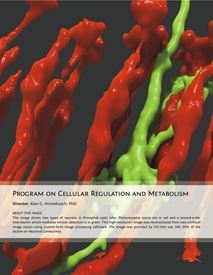You are here: Home > Program in Cellular Regulation and Metabolism
Program in Cellular Regulation and Metabolism
Director: Alan G. Hinnebusch, PhD
The seven investigators in this program, all belonging to the Laboratory of Gene Regulation and Development (LGRD), apply a combination of genetics, biochemistry, cell biology, and structural biology to elucidate the molecular basis of processes fundamentally important in cell biology or animal development. Three of the seven groups study molecular mechanisms of transcriptional and translational control of gene expression, and the transposition of retroelements in budding or fission yeast. Two groups employ the fruit fly Drosophila to investigate molecular mechanisms in development, including the molecular basis of neuronal connection specificity in the visual system and of cell signaling by TGF-beta factors. The aneuran Xenopus laevis serves as a model system for the work of the remaining two groups, which focus on chromosome segregation and cell cycle control and transcriptional programming of organ development during metamorphosis.
Members of the Section on Nutrient Control of Gene Expression, headed by Alan Hinnebusch, study mechanisms of transcriptional and translational gene regulation. Recently, they identified structural elements in translation initiation factor 1A (eIF1A) that, by controlling distinct modes of initiator tRNA binding to the 40S ribosomal subunit, regulate ribosomal scanning and accurate start codon selection. The group also implicated a segment of the alpha-subunit of eIF3 in 40S attachment to mRNA and a segment of the beta subunit of eIF2 in the binding to its guanine nucleotide exchange factor, eIF2B. They showed that the histone H4 acetylase complex NuA4 is recruited to coding regions and promotes co-transcriptional histone eviction and transcription elongation, and they identified a two-stage mechanism for recruitment of the deacetylase complex Rpd3-S to coding regions involving the phosphorylated C-terminal domain of RNA Polymerase II and methylated histone H3. Lastly, they identified multiple redundant elements in the Mediator subunit Gal11/Med15 that support Mediator recruitment to enhancers by transcription activator Gcn4.
The Section on Cell Cycle Regulation, headed by Mary Dasso, uses a variety of metazoan systems, including Xenopus laevis egg extracts and mammalian tissue culture cells, to study the mitotic roles of the Ran GTPase, the nuclear pore complex (NPC), and the SUMO family of ubiquitin-like proteins. The Section's analysis of the Ulp/SENP family of SUMO proteases showed that the enzymes play essential roles at mitotic kinetochores, as well as in ribosome biogenesis and checkpoint control of the cell cycle. The Section also demonstrated novel roles for NPC components in kinetochore function and spindle assembly.
The Section on Protein Biosynthesis, headed by Thomas Dever, is characterizing the structure and function of several translation initiation factors and the molecular principles of kinase-substrate recognition by the stress-responsive eIF2alpha kinases. The Section recently reported that binding of the kinase domain of the eIF2akinase PKR induces a conformational change in its substrate eIF2ato, exposing the phosphorylation site and thus restricting translational regulation to the eIF2alpha kinases. The group also demonstrated that the hypusine-containing protein eIF5A promotes translation elongation.
Henry Levin heads the Section on Eukaryotic Transposable Elements, which analyzes LTR retrotransposons and the integration of their cDNA into the chromosomes of host cells. Recently, the laboratory adapted methods of deep sequencing to determine the position of 73,000 insertions throughout the genome of Schizosaccharomyces pombe. The data provided a reproducible and saturating profile of integration activity for each intergenic sequence and ORF. While integration occurred primarily in promoter sequences, the majority of the insertions were concentrated in just 31% of the promoters. Promoters induced by conditions of stress were preferred targets of integration. Other experiments examined the insertions in the fbp1 promoter and found that the transcription factor Atf1p mediates integration while other factors that promote fbp1 transcription do not.
The Section on Neuronal Connectivity, headed by Chi-Hon Lee, investigates the development and function of color-vision circuits in Drosophila. By systematically inactivating or restoring the activity of specific neuronal types and examining the behavioral consequences, his group mapped the first processing stage of the chromatic circuits. Recently, his group developed a novel technique called dual-view imaging, which combines two confocal image stacks acquired orthogonally to generate high-resolution 3D images of neuronal processes. The group also studied the regulatory role of TGF-beta/Activin in the development of amacrine neuron dendrites.
The Unit on Cellular Communication, headed by Mihaela Serpe, investigates molecular mechanisms that regulate cellular signaling during development, using the Drosophila system. The group focuses on signaling by TGF-beta factors and on genes that modulate the function and distribution of these signaling ligands in time and space. The group's studies showed that molecular differences in BMP transporters—Sog in Drosophila and Chordin in vertebrates—are important for the different systems to acquire robust and reliable patterning.
The Section on Molecular Morphogenesis, headed by Yun-Bo Shi, studies the gene-regulatory mechanisms that are controlled by the thyroid hormone receptor (TR) and establish the developmental program of metamorphosis in Xenopus laevis. The group used microarray analysis to identify the gene-regulation pathways governing this process and revealed distinct roles of TR-regulated matrix metalloproteinases and a TR-coactivator in regulating larval cell death and adult stem cell development in the metamorphosing intestine.



